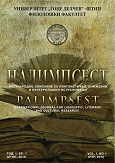LES PUISSANCES CÉLESTES ET LA SECONDE VENUE DU CHRIST SUR LES FRESQUES DE SAINT-GEORGES À POLOŠKO
The Celestial Powers and the Second Coming of Christ in the Painted Decoration of St. George at Pološko
Author(s): Ana PopovaSubject(s): Cultural history, Architecture, Visual Arts, History of Art
Published by: Универзитет »Гоце Делчев« - Штип
Keywords: St. Georges at Pološko; Angelic orders; Second Coming of Christ; Mausoleum.
Summary/Abstract: The church of St. George at Pološko was erected between 1334 and 1343 as a mausoleum for the donor of the church John Dragušin. The church decoration, executed in 1343-5 offers specific iconography that complies with the funeral character of the church. This also refers to the painting of the dome (fig. 1) that includes the post-Byzantine representation of the Holy Trinity (fig. 2) in the calotte surrounded by angels (fig. 3), the hexapteryga (six-winged angels, fig. 4, 5) in the pendentives, the evangelists and the apostles on the arches under the dome and the prophets and ancestors of Christ in the drum and on the vaults. The celestial powers decorating the dome are completed by two archangels depicted on the pillars under the dome: Gabriel (fig. 6) and Michael (fig. 7). As in other contemporary churches, the fourteenth century dome decoration had to include the image of Christ Pantocrator. Eight angels in prayer, dressed in antique and imperial garments (fig. 3) surround the Pantocrator. In Byzantine churches the angels in prayer surrounding the Pantocrator evoque the Second Coming of Christ. Accompanied by the prepared throne, or Hetoimasia, the Virgin, St. John the Baptist and the Pantocrator from the calotte these compositions form Deesis and refer to the Second Coming of Christ. In the fourteenth century domes Pantocrator is rarely surrounded only by angels in prayer. These representations also evoke the Second Coming of Christ through hexapteryga associated with these programs. Apart from Pološko, examples can be found in the church of Agios Nikolaos tis Stegis (St. Nicholas of the Roof) in Kakopetria where seraphims are introduced between angels in prayer and in the dome of the narthex of Lesnovo (fig. 8) where hexapteryga are on the pendentives. At Pološko the iconographical evocation of the Second Coming in the calotte is reinforced with the depiction of the Deesis (fig. 9) under the dome in the lower zone. Another particularity of the iconographic program is the seraphims in the west pendantives (fig. 4), and tetramorphs (fig. 5) in the east pendentives. The inclusion of hexapteryga in the iconography of the dome in Pološko continues an old tradition that goes back to the sixth century dome of Hagia Sophia in Constantinople. From the middle Byzantine period the evangelists are almost regularly depicted in the domes. Still, there are some exceptions, such as the dome of Panagia Chalkeon (1028), of Nea Moni of Chios (eleventh century), the dome of Holy Apostles in Perachorio (1160-1180), or the domes from several Cappadocian churches from the tenth and eleventh century. In the thirteenth century this tradition is continued at St. Mark in Venice. The hexapteryga return in the iconography of pendentives in the fourteenth century. They reappear in the dome of the prosthesis of Chora, in the dome of the narthex at Lesnovo, in the dome of the chapel of St. Nichola in the monastery of St. John Prodromos in the Mount Menoikeion and in the churches of Mistra: Afendiko, Pantanasa and Hagia Sophia. In the cases where hexapteryga return in the iconography of the domes, the iconography also underlines the Second Coming of Christ. Therefore, they are often depicted in pendantives of lateral domes in spaces with funeral dedication. That is the case in Afendiko in Mistra, in Lesnovo or in the chapel of St. Nichola in the monastery of St. John Prodromos in the Mount Menoikeion,. In St. George at Pološko the xecapteryga appear in the main dome, reflecting the funeral character of the whole church, where the donor was buried. The two archangels: Gabriel (fig. 6) and Michael (fig. 7) are located on the pillars under the dome. Thus the iconography has added them to the other angelic orders subordinated to Christ. By their royal costume loros and their attributes scepter and globe, inspired by the imperial court, these figures contribute to the exaltation of the heavenly sovereign. Their place on the pilasters under the dome allowed the faithful entering the church to see aligned on the same axe, Christ Pantocrator in the summit of the dome, the angels worshiping him in the calotte, hexapteryga on the pendantives and archangels on the pilasters under the dome. By representing the archangels on the pilasters the iconography has also allowed for the archangel Michael to be depicted next to the Deisis (fig. 9) represented on the north wall under the dome. In this manner this psychopomp par excellence has become an intercessor for the salvation of the soul of the donor. The rare iconography of the dome and the space under it is in accordance with the painted funeral programs of other areas of the church. The reasons for the deviation from the Byzantine programs lies in the fact that unlike other contemporary churches where secondary spaces had funeral dedication the primary space of the monument was a mausoleum. Thus the study of the iconography of the dome reveals an apocalyptic meaning suitable to the destination of the space: angels and hexapteryga allude to the Second Coming of Christ. Accompanied by archangels on the pilasters under the dome, these angelic orders exalt the heavenly sovereign. Moreover, the image of the Deesis on the north wall under the dome reinforces this idea of the end of time, emphasizing the hope of redemption and confirming the soteriological meaning of the painted program.
Journal: Палимпсест, Меѓународно списание за лингвистички, книжевни и културолошки истражувања
- Issue Year: 1/2016
- Issue No: 2
- Page Range: 127-142
- Page Count: 16
- Language: French

